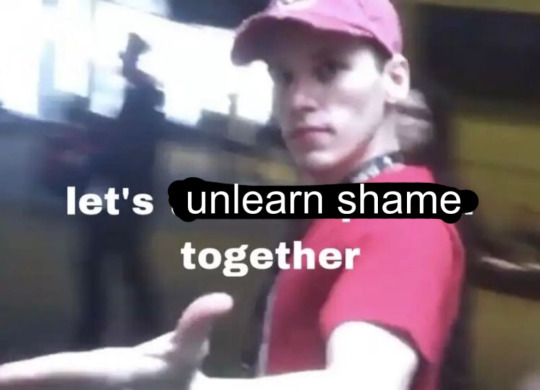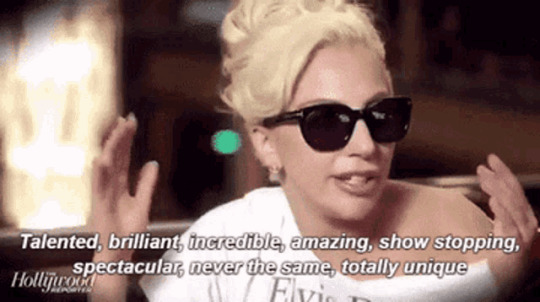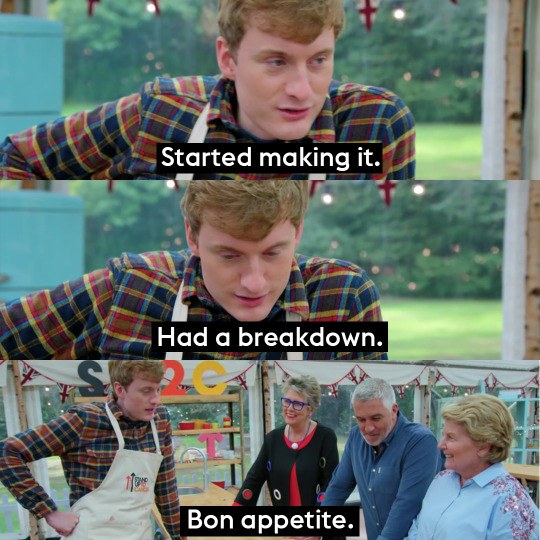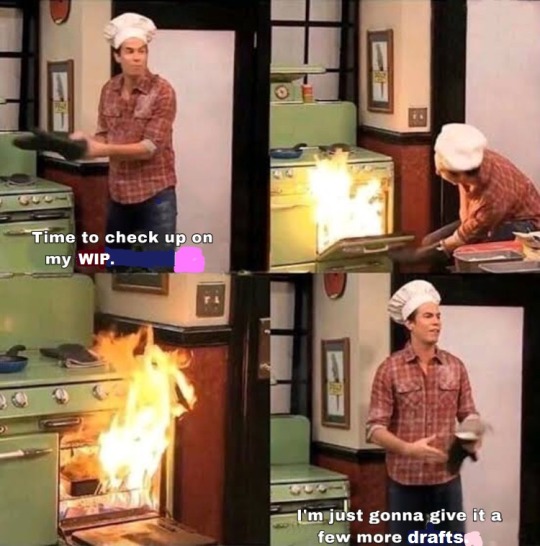#communicative process
Explore tagged Tumblr posts
Text
Honestly, I love it when characters relapse. When someone who’s gotten over their anger issues falls into a situation so out of their depth they fall back on their old habits. When someone who’s learned to open up becomes a recluse again in order to cope with something outside their control.
There’s just something so horrible, so toxic, about watching a character grow and then slip back into their old selves in order to cope, bc you know they still care, that they’re the same inside, but watching them hurt so hard they don’t know what else to do brings a sense of catharsis.
#writeblr#writing#writers on tumblr#writing community#creative writing#my writing#fanfic#fanfiction#one of those tropes that has to be played carefully tho#it’s important to show them wresting with it#and realizing what they’re doing#but being so lost in their pain they don’t know what to do#show they’re contrary feelings and that they’re still the same inside#it’s just a defense mechanism#also don’t make it seem like a flick of a switch#a slow process of relapse and a slow process of recovery from it is also important#not a plot twist for the sake of it#or played for drama#but a legitimate change with real consequences#just yappin#writing prompts#writing tropes#writing stuff#writing characters#characters#character arcs#oc stuff#tropes#trope talk
22K notes
·
View notes
Text

#i’ve been thinking abt that cringe post#i think the latent feelings behind ‘cringe’ are shame and sometimes envy/bitterness#same vibes as when six year olds say ‘those toys are for babies’ if they’ve been shamed for their age by older kids#anyway. i think part of the healing process is realizing that shame puts you at war with yourself bc part of yourself is a social being!#and that part of you wants community and acceptance (maybe love). shame is the absence of acceptance#unlearning shame means learning self-love and gaining the confidence to find your people#jerma#cw jerma#(someone asked me to tag lol)
59K notes
·
View notes
Text
Daydreaming about my book:

Writing my book:

#writing memes#writing#writing community#writers on tumblr#writing problems#writing mood#writing process#char speaks#char rambles
34K notes
·
View notes
Text

#it's been a few days--have another plot bunny meme#plot bunny#gru meme#despicable me#writeblr#writblr#writing#writer problems#writer community#writers on tumblr#writers and poets#writerscommunity#creative writing#writing humor#writing memes#writing problems#writing process#writer#writers community#writing community
7K notes
·
View notes
Text
This is a friendly reminder to give your OC a firm and unmistakable L every now and then.
This is a necessary action to keep your OC healthy for the long term.
#oc#oc writing#oc wip#writing advice#writing process#creative writing#writers on tumblr#writing#writers#writers on ao3#ao3#writeblr#writing community#writing help
28K notes
·
View notes
Text
Writing Advice:
1. Write what's in your heart
2. Wait, hold up
3. THIS is what's in your heart?
4. Dear god
5. Your poor characters.
6. Why is there so much blood and death?
#writing advice#books#writing#writersnetwork#writers#writers on tumblr#writing community#author#writerscommunity#writers life#tumblr writing community#writer problems#writer things#writers of tumblr#writer#writing process#lists by authors#unknown contributors
13K notes
·
View notes
Text
You don't wish your disability was worse or more visible, you wish your disability was taken seriously. Please stop confusing the two, I guarantee you would not get the support you need JUST by being more severe or more visible. Please listen to visibly disabled people when we tell you it isn't better on our side
#m/cc#mine#I tried extremely hard to word this nicely because I KNOW people don't mean bad and often even know there are unique challenges#and believe me I know the challenges of invisible disability too!!#I have invisible disabilities!#but as someone who has also been at least visibly 'off' since they were 10 I am SO SICK of invisible disabilities being hailed as like#a unique extra oppression that us lucky visibly disabled people don't have to deal with#there are challenges to invisible disabilities that visibly disabled people DON'T have to deal with!#but you need to understand that *the reverse is also true*#there are MASSIVE benefits to being able to lie about your disability for example#or not dealing with the overt ableism that comes with your disability being obvious to everyone#*I do not have the option to pretend I'm not disabled.* that is never an option I have#I walk weirdly. I use a mobility aid now. my speech and face are 'off.' I lean to one side#for a long time I wore sunglasses 24/7 and often didn't make sense. I sometimes can't speak or won't react to others#for the most part people will always know that at the very least something is wrong with me#and more obviously I have people telling me they'll pray for me; telling me I can't do things I'm already in the process of doing;#wanting to shake my hand to tell me I'm an inspiration for not killing myself; giving me dirty looks for existing in public#and yes. I'm aware that this is very much an in-community issue. I know the average abled person doesn't know invisible disabilities exist#that's why there's so much awareness happening for it#but as a visibly disabled person I get SO TIRED of constantly hearing 'I wish my disability was visible :'('#it's just 'I wish I had your disability!' but from other disabled people
8K notes
·
View notes
Text

#writblr#writers on tumblr#writing community#writers of tumblr#WIPs#creative writing#writer#writers#writeblr#writing problems#writing process#writing meme#writing memes#queue
10K notes
·
View notes
Text
me writing: i am a god and reality bends to my whims
me proofreading: im too stupid to be alive
#writing memes#writing#writing community#writers on tumblr#writing problems#writing mood#fanfic#fanfiction#fanfiction memes#writing process
20K notes
·
View notes
Video
Sheltered Environments : Photographic Architectures : Stonehenge Visitors Centre 03. by Russell Moreton
#shelter#Stonehenge#visitors centre#enclosure#volume#steel#glass#limestone#chestnut cladding#Denton Corker Marshall#pinhole camera#analogue#sheltered skies#disparate literatures#ideas#artifacts#disciplines#reference management#communicative process#fields#inquiry#russell moreton#working practice#work flow#process of translation#sociological language#visual fine art#spatial practice#research creation#ecology of experience
4 notes
·
View notes
Text
being a writer is googling "reddish pink color name" and not getting the objectively correct answer
#writing community#writeblr#writing#writers on tumblr#writers#writer#writerscommunity#female writers#writing process
2K notes
·
View notes
Text
HOW THE HELL AM I SUPPOSED TO WORK FULL TIME AND GO TO SCHOOL FULL TIME AND WRITE GOOD STORIES AND HAVE A SOCIAL LIFE AND WORK ON MYSELF AND BE A GOOD FRIEND AND CONTRIBUTE TO MY COMMUNITY IN THESE CONDITIONS
(The conditions are: living in the United States)

#female writers#writeblr#writers and poets#writers on tumblr#creative writing#my writing#writer#writers#writers of tumblr#writerscommunity#aspiring writer#writing process#on writing#writing#tumblr writing community
1K notes
·
View notes
Text
Creating Emotionally Devastating Scenes.
Crafting a scene that earns the total sympathy of your readers can be challenging, but it's not impossible. Most emotionally devastating scenes fail at two things, but when these are done right, the results can be powerful.
⚪ The Important Concepts for Writing an Emotionally Devastating Scene
1. The Build-Up,
2. Breaking the Dam.
Before I explain these concepts, let me share a case study.
⚫ Case Study
I wrote a story about a young orphan named Jackie and her younger brother. Their village was burned down, leaving them as the only survivors.
For the next few chapters, readers followed their painful journey and their struggle to survive. The younger brother had a heart problem, and Jackie vowed to become a cardiologist to save him.
She was very ambitious about it, but at the time, it was very ironic. Later in the story, when they encountered a tragic living condition with a family, the brother died while telling his sister how much he missed their parents.
When her brother was fighting for his life, she was sent out of the room, only to be let in again to see his cold, lifeless body.
⚪ Explanation of Concepts
1. The Build-Up
The build-up is extremely important when you aim to convey strong emotions. Here's a secret: if you plan for a scene with strong emotions, start leaving breadcrumbs from the very beginning of the story.
Take the previous case study. I carefully built up their journey so people could easily relate and feel the pain of the older sister during her brother's sudden death.
You need to give the situation enough reason to feel utterly hopeless and devastating. Gradually cultivate the tension until it's ready to let loose.
⚫ Understanding the Use of Breadcrumbs.
Breadcrumbs in stories ensure you utilize the time you have to build up certain emotions around your characters.
At the beginning of my story, Jackie’s fate was already pitiable, but she survived every hurdle. This gave the readers enough to feel for her while still leaning away from the outcome. When I built enough, I introduced her brother's sudden death.
Hence, leave your breadcrumbs while leaning away from the outcome.
⚪ How to Properly Leave Breadcrumbs
When building up your story, consider these elements:
☞ Character Relatability: The characters need to be realistic to draw readers into the story. This helps readers invest themselves in your story.
☞ Realistic Emotional Pain: Just as characters need to be relatable, their emotions need to be realistic and not appear forced.
☞ Create a Strong Emotional Attachment: Give them something they care about or that has the power to ruin their lives in any way. It could be something that makes them happy or something their happiness relies on. When it's time, snatch it away without remorse.
☞ Have a Backstage Struggle: This struggle keeps readers occupied, so they won't see the outcome coming. For example, Jackie’s constant struggle to find food and shelter keeps readers engaged while the impending tragedy looms in the background.
☞ Attach Believable Elements: For a realistic character, emotion, and struggle, attach believable elements. It could be death, ailments, sickness, disorder, disappointment, failure, etc.
Now that we've covered the build-up, let's move on to the next crucial part.
2. Breaking the Dam
This is when you make your readers feel the strong emotions alongside your characters. All the tension you’ve been building up is released, making all emotions come into play.
☞ Break Your Strong Attachment: Cut off your strong attachment from your character when they least expect it or at a point when they couldn't use more struggles (i.e when they are helpless).
This will not only evoke readers’ emotions but also pique their curiosity as they wonder how the character will survive the situation.
☞ Description of Sensory Details to Invoke Emotions: The advice of "show, don't tell" will be really helpful here. It's crucial to ensure that the final execution matches the build-up.
A well-crafted build-up can fall flat if the emotional release isn't handled effectively. To avoid this, blend the climax seamlessly into the narrative, making it feel natural and impactful.
Reblog to save for reference! 💜
#writing#writeblr#writers on tumblr#writer#writers and poets#writerscommunity#writing community#wattpad#ao3 writer#a03 writer#writers of tumblr#aspiring author#aspiring writer#writing advice#writing blog#creative writing#writing discussion#writing encouragement#writing guide#writing help#writing ideas#writing journey#writing life#writing motivation#writing novels#writing on ao3#writing process#writing resources#writing reference#writing requests
2K notes
·
View notes
Text

#writeblr#writblr#writing#writer problems#writer community#writers on tumblr#writers and poets#writerscommunity#creative writing#writing humor#writing memes#writing problems#writing process#writer#writers community#writing community
1K notes
·
View notes
Text
Writing Character Accents in Fiction
Hey there, thanks for the question! I speak English as a second language; most English speakers I encounter aren’t native (yes, including fictional people); thus, this is a concern I’ve explored personally when I write.
I think the core principle regarding accent writing is this: it shouldn’t be distracting.
For the same reasons why Stephen King prescribes the basic dialogue tag “said” rather than fancier alternatives like “whispered”, “shouted” or “screeched”, dialogue must be first and foremost easy to read. It must flow like a real conversation – the pace and tone are a lot more important than how specific words are being pronounced by the character.
Focus on what effect the accent has:
Using adjectives to describe their voice in general. Different types of English (American, British, Australian, etc.) will give off a different vibe, also partly dependent on how your character speaks in general:
Lilting: Having a smooth rise and falling quality; sing-song like. Welsh accent is often described as singing.
Posh: from a high social class. This is the term generally used to describe the upper-class British accent.
Nasal: this happens when the sound goes through somebody’s nose when they’re speaking. North American accents are more nasal than, say, British pronunciations.
Brash: harsh, loud, indicative of sounding a little rude.
Slur: speaking indistinctly; words merging into one another.
Using metaphors.
Her voice was cotton and fluffy clouds.
When he spoke, the ‘r’s scratched the insides of his throat.
Mentioning their accent with a brief example(s).
“Would you like to drink some wine?” she said, though her Indian accent gave extra vibration to her ‘w’s and ‘r’s, making the words sound more like ‘vould you like to drrrink some vine’.
“I want some chocolate.” His syllables were choppy and ‘l’s rather flat, saying ‘cho-ko-lit’.
Some Tips:
Don’t phonically spell out everything. Perhaps give a few examples in the beginning, but stick to standard English spellings.
Pay attention to word choice, slang, and colloquialisms.
An Australian person would say “tram”, not “trolley; “runners” instead of “sneakers”
A Canadian may refer to a “fire hall” – what Americans call a firehouse or fire station
If your character comes from a non-Enligsh background:
Use vocabulary from other languages.
“What time was the exam, ah? Two o’clock? Jiayou!” → putting “ah” or “la” at the end of sentences + Jiayou means “break a leg” in Singlish.
“I can’t believe that 4-year-olds have their own SNS accounts now.” → “SNS” is short for “social networking service”, a term used to refer to social media in Korea. This would a subtle difference – even though it isn’t technically Korean at all!
Transpose grammar from different languages.
For example, in French, plural nouns take plural adjectives (whereas in English, you would speak of ‘white cars’, not ‘whites cars’).
─── ・ 。゚☆: *.☽ .* . ───
💎If you like my blog, buy me a coffee☕ and find me on instagram! Also, join my Tumblr writing community for some more fun.
💎Before you ask, check out my masterpost part 1 and part 2
#writers and poets#writers on tumblr#writing#helping writers#creative writing#let's write#creative writers#poets and writers#writeblr#resources for writers#ask blog#ask me anything#answered asks#writing process#writing advice#writing inspiration#writing community#writer#writerscommunity
3K notes
·
View notes